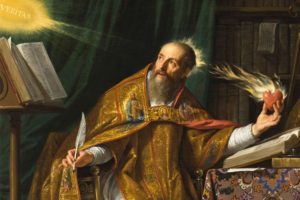In my recent Creedo Magazine post, Looking from This Pope to the Next, I suggested that Pope Benedict XVI may go down in history as one of the more evangelical-friendly popes on account of his commitment to biblical theology and his resolute stand for truth’s objectivity against the “dictatorship of secularism.” Timothy George, writing for First Things Journal, makes a similar case in his article Benedict XVI, the Great Augustinian. It is important to remember, however, that even amidst such similarities, significant differences continue to distinguish the pope’s approach from evangelical Protestantism. I cited a few obvious examples in my above-mentioned article, including Dominus Iesus (2000), which asserts that Protestants “are not churches in the proper sense” and that “they suffer from defects,” and the pope’s granting of permission for priests to celebrate the Mass in Latin according to old, Tridentine rites. In what follows, the Italian theologian Leonardo De Chirico helps us to think through these differences more carefully, providing a helpful assessment of Pope Benedict XVI’s pontificate from an evangelical point of view:
Assessing a pontificate is no easy task. Assessing Benedict’s pontificate (2005-2013) is even more difficult. The caliber of Ratzinger as a theologian, the muddled state of present-day Vatican affairs, and the complexity of global religious and moral trends, … these are all factors that call for careful consideration, although his pontificate will perhaps be remembered more for the shocking way it ended than for what it achieved. Our task here will be more modest. It will take as parameters the main bullet points that characterized Evangelical perceptions of Benedict’s pontificate. It will be an exercise to see to what extent they match reality.
Orthodox
A recurring comment is that Benedict XVI has been an “orthodox” pope. In this case, orthodox means maintaining Nicene Christianity, i.e. the Trinitarian and Christological confession of faith of the early church. In itself, being orthodox is not a distinct feature of any single Pope because it is part of his service. The pope, or any pope, is to be orthodox. Boniface VIII, the pope that introduced the papal tiara in 1300 (indicative of the temporal power), was orthodox. Pope Leo X, the one who excommunicated Martin Luther in 1521, was orthodox. The best and the worst popes were orthodox. Indeed, all 265 Popes since Peter have been orthodox. The business of the Pope is to be orthodox in this Nicene sense.
It may be true that Benedict put a special emphasis on orthodoxy, but he has interpreted his orthodoxy in a Roman Catholic way, like all previous Popes. He has been praying daily to Mary, he has granted indulgences, he has canonized new saints, he has maintained the church-state profile of the Vatican, etc. Contrary to what C.S. Lewis believed, there is no “mere orthodoxy” out there. Nicene Christianity is always colored by subsequent developments in Christian doctrine and practice. It never stands in isolation nor does it exist in an abstract way. Benedict’s pontificate has been a peek of Roman Catholic orthodoxy.
Biblical
It is true that in his catechetical efforts, Benedict has been dealing with the Bible much more than his immediate predecessors. His speeches have largely been Biblical meditations and his recent writings on Jesus have defended the historicity of the Gospel accounts. Much of his reading of Scripture, however, was shaped by post-biblical presuppositions that come out of ecclesiastical tradition rather than Scripture itself. The heavily sacramental interpretations of Gospel stories and the over-arching interpretive grid that sees the relationship between Biblical teaching and Roman Catholic practices in terms of linear continuity, are only two examples of “how” Biblical Benedict’s magisterium has been. During his pontificate, the point that distinguished Roman Catholicism from the Protestant tradition was no longer whether or not the Bible is accessible to the people, but “how” it is to be read and lived out.
There is still another aspect to bear in mind. The Pope’s most famous (and criticized) speech, i.e. the 2006 Regensburg lecture, was not about Islam, but revolved around the need to keep the Hellenized combination of “faith and reason” which Thomas Aquinas refined at its best and which the Roman Catholic Church holds onto. In denouncing the threats to the “classic” synthesis, Benedict indicated the “sola Scriptura” of the Reformation as a major breach that eventually caused theological liberalism and present-day relativism. It is interesting that a “Biblical” Pope would have such a low view of the Reformation’s formal principle that brought the Bible back to the center of the life of the Church.
Public Truth
Benedict has courageously stood for basic Judeo-Christian convictions about life, the family, and the welfare of society characterized by freedom and solidarity, even in the midst of criticism from secular intellectual circles. Like his predecessor, John Paul II, Benedict was commended by Muslim and other religious leaders for his tenacious defense of traditional morality in the global world. His Church, however, did not perform well in terms of public transparency and integrity with regards to the sexual abuses scandals, the opaque financial maneuvers, and the appalling intrigues within the Vatican. During Benedict’s reign the distinction between the standards of the official Church and those of the world has been thin if not impalpable. He is not to blame for all this, yet this poor “public” performance sheds light on the overall picture. This is perhaps one of the reasons why Benedict came to the almost unprecedented conclusion to resign from the papal office.
The Pope spoke of Christians as a “minority” and encouraged the Church to re-think its identity accordingly. The fact that he did not take any action to move his Church beyond the privileged status it has in many countries where Catholics are majority puts his record as a “public truth” teller in perspective. Would it not have served his vision of the Church’s public identity to rethink its role as a religious agency with a built in state with its own politics, bank, army, etc., like any other state of the world?
New Evangelization
The New Evangelization was an idea of John Paul II, but Benedict XVI started implementing it by creating a Vatican office dedicated to it and by making it the central theme of the 2012 Synod of Bishops. Pope Ratzinger has come to terms with the idea that the West is largely post-Christian and is in need of being evangelized again by a reinvigorated Church.
The future will tell what the New Evangelization will bring about in terms of spiritual renewal. Yet, so far there has been little self-criticism on the Church’s part as to why the West became more secularized. Does the Church have any responsibility in the secular “schism” that has taken place? No clear answer has come from this Pope who has instead blamed the modern world for it.
In the meantime, Benedict has continued calling “sects” those that are engaged in evangelism, including Evangelicals in the Global South, not making the distinction between New Religious movements and Evangelical Christianity.
Beyond extremely positive assessments based on selected aspects of Benedict’s pontificate, Evangelicals have food for thought in order to come to a more nuanced and perhaps realistic view of his office as a Pope.
Leonardo De Chirico
leonardo.dechirico@ifeditalia.org
Rome, 25th February 2013





